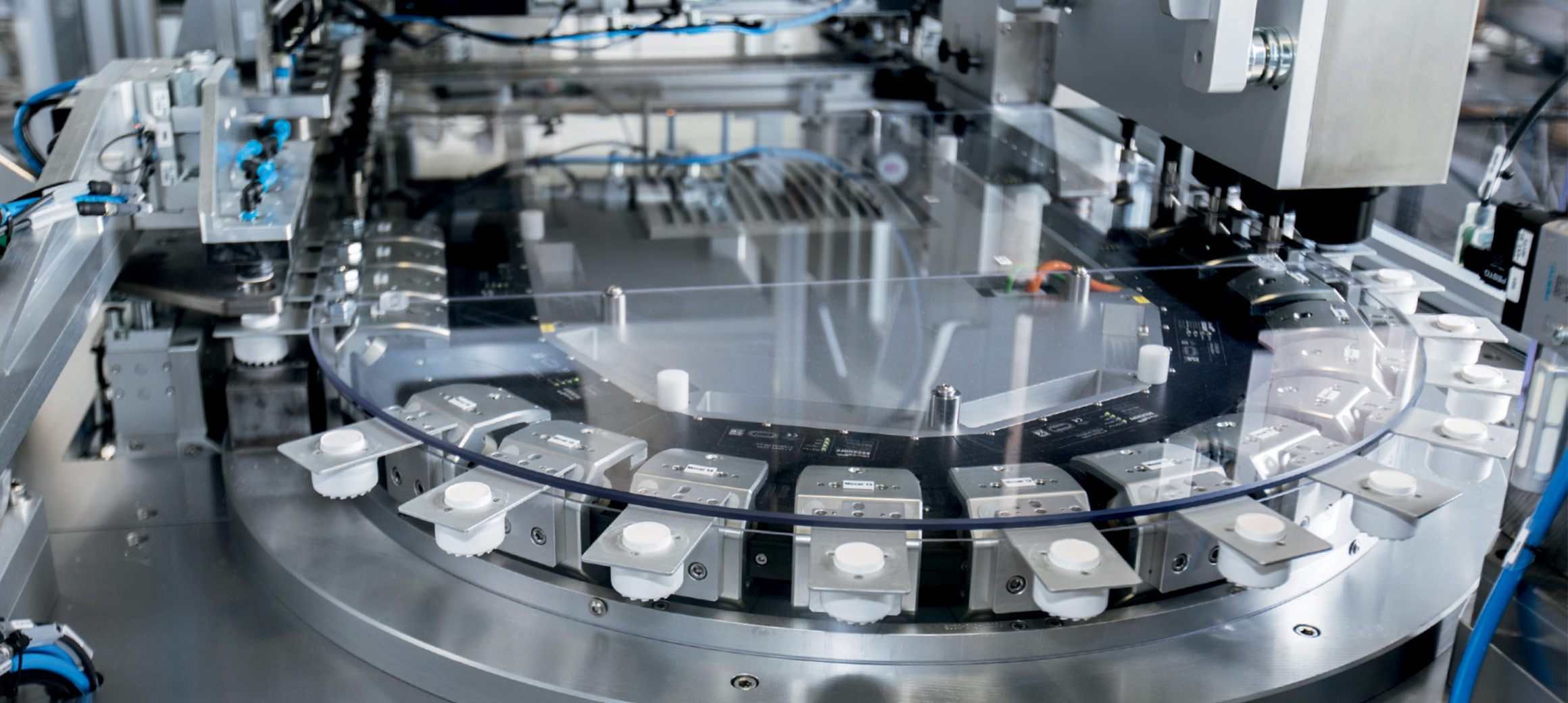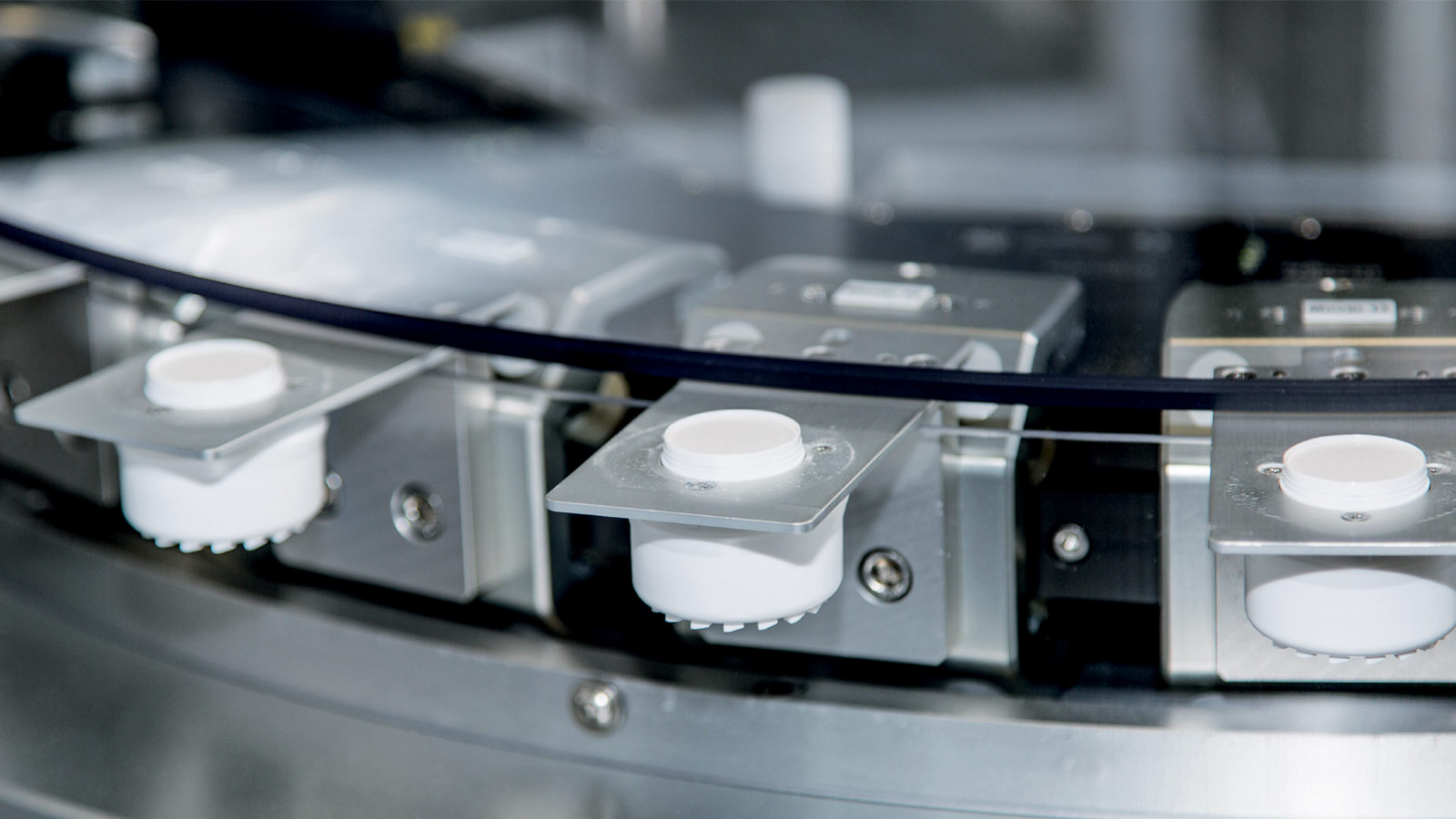

eXtended Transport System helps to implement innovative design of specialty pharmaceutical machine with minimized hardware needs
Fully automating production processes that were once manual or semiautomatic presents special challenges when the cycle times involved are extremely short. With workpiece carrier systems operating on a fixed cycle time, accommodating the differences between individual processing stations’ motion profiles involves setting up multiple stations of a given type to operate in parallel. This prompted Goldfuß Engineering GmbH in Balingen, Germany, to deploy its first Beckhoff eXtended Transport System (XTS) on a medical pill packaging line. The XTS uses software functionality for flexible buffering to deliver a highly dynamic solution that ideally meets the line’s transport needs and helps to reduce the number of components to a minimum.
Goldfuß designs and builds a range of handling and production systems, including specialty machinery used in plastics engineering and the food and pharmaceutical sectors. To support high-speed processes with a throughput of up to 60 parts per minute, these systems rely on exceptionally precise feed, positioning, processing and inspection operations to function effectively. XTS offers systems like this a compact transport solution with the flexibility and rapid product changeover capabilities they need. At the same time, XTS, with its advanced software functionality, paves the way for entirely new approaches to implementing highly dynamic machine setups and configurations, where motion tasks that once bordered on the impossible or would have called for highly complex solutions can now be implemented with unprecedented ease and flexibility. As Michael Müller, a member of Goldfuß’s executive management team and head of special-purpose machines sales, explains, “Unlike fixed-cycle-time workpiece carrier systems, which require that we provision as many as four instances of certain processing stations, XTS and its software functions give us enormous flexibility. We can use as many movers as we need, and we can time how they operate to match the way processes execute.”

Goldfuß put this approach into practice in 2017 in a specialty machine that assembles pill bottle caps. These are safety caps that are also filled with a desiccant. The assembly process is not just challenging from a mechanical perspective, it also has to comply with FDA 21 CFR Part 11 regulations to ensure that the packaging used for the medicines is absolutely clean and sterile. For the most part, assembly machines of this kind are located in cleanrooms, so the automation system control cabinets need to conform to Class 8 cleanroom standards as well. In addition, customers expect a rapid output rate, minimum production risk, and a high degree of flexibility and process reliability.
New-found freedom with XTS
Besides exceptional speed, XTS provides outstanding flexibility to accommodate differences in the timing of processing stages in which parts are provisioned, positioned, assembled, inspected and ejected, and so keep cycle times below one second. “We wanted to implement a system that we could set up without having to depend on a specific number of processing stations. Given the cycle time constraint, it was important that we were free to choose components as we wished and could accomplish the flexibility we wanted through the number of movers,” Michael Müller explains. He adds: “We looked at various workpiece carriers and systems with fixed cycle times. However, with a fixed-cycle carrier, you need the same number of systems for all the stations as you do for the bottleneck station if you want to successfully maintain the required cycle time. In our case, that would have meant using four camera systems, four processing stations and four assembly stations. This is why we opted for the much more flexible XTS solution instead.”
Injection-molded parts for the safety caps are provisioned in bulk via a spiral conveyor and fed into the system, where they are inspected by a number of cameras, then placed in XTS movers equipped with appropriate mounts. The movers transport the caps to processing stations that punch cardboard disks, carry out ultrasonic welding, and perform various assembly tasks. In between, the parts are inspected repeatedly at camera stations; they are also checked on a weigh scale at the end of the overall process. The processing and inspection stations are connected by an oval XTS transport track with a total length of around 7.5 meters, made up of 20 straight and eight 45° curved motor modules, each 250 millimeters long. Roughly 34 movers acting as workpiece carriers travel along the track. The entire system is controlled by a C6930 Industrial PC for control cabinet installation.

The movers on the cap assembly line can be grouped in any number of ways within the product stream – in other words, they can travel to processing stations individually or in groups. Movers are controlled individually, as separate servo axes, but they can be synchronized with other movers or with process workflows, too, if required. Depending on the task in hand, they are able to travel independently (no matter what their absolute position might be) and can operate relative to one another as well. This allows a flexible buffer to be formed from which individual processing stations can be served on a highly dynamic basis to match their actual processing performance.
PC-based control in an open, compact, end-to-end system
The system processes granular material, so it is pressurized and therefore completely enclosed to guard against high levels of dust and dirt. The handling equipment – the elements that variously grasp, lift, push against and compress the parts being processed – is controlled pneumatically by valve terminals. A conveyor weigh scale checks the fill weight of the products at the end of the line. The entire system is controlled by a C6930 Industrial PC, operated from a CP3919 19" multi-touch Control Panel connected via a CP‑Link 4 combined power and data cable. Data communication with XTS takes place on an ultra-fast EtherCAT link; the camera systems are connected via TCP/IP over Ethernet. The ultrasonic welders are fitted with TwinSAFE safety equipment, which includes EL6900 TwinSAFE logic terminals, used to implement safety functions, such as an emergency stop (STO) and safe stops (SS1 and SS2). There are also various analog and digital input and output modules.
XTS’s simple and compact design has distinct benefits, as Michael Müller explains: “The principle advantage of XTS is that the drive and power electronics and the position measurement system are all contained in the motor modules – in other words, in the actual XTS track. Were it not for XTS, our assembly line would need somewhere in the region of 200 to 300 motors, and the drive control gear would fill a very large cabinet. With XTS, we need to run just two connecting cables to the control cabinet – one for EtherCAT and one for the 24/48-V power supply. A C6930 Industrial PC with an Intel® CoreTM i7 quad-core CPU running TwinCAT software manages the individual movers as servo axes, complete with all the usual motion control functions like electronic gearing and camming. These not only allow the workpiece carriers to queue up and move off jolt-free, they also limit the centrifugal force occurring on curved sections of the track. Due to parallel processing on the multi-core CPU, the compute power available is far greater than would be the case with sequential processing on a single core, making XTS applications like this exceptionally efficient to implement.”
Assembly line with increased flexibility and reduced mechanical complexity
As a rule, the XTS movers arrive at a given processing station in series, but they can be sent to multiple stations of the same kind in parallel if the cycle time requires it. For instance, if a processing cycle takes longer than one second, the number of processing stations needs to be increased accordingly – say, to two, three or four. Ultrasonic welding takes between three and four seconds, so to keep within the cycle time constraints, Goldfuß currently operates three ultrasonic welding units in parallel, with a fourth on standby in case the cycle time increases. With the assembly stations, the situation is essentially the same. They put together four caps at once. Leveraging the high speed of the movers, the machine as a whole can compensate for an increased number of stations being used and nevertheless maintain its required cycle time exactly. This enables the line to achieve a throughput 60 parts per minute. The high-speed camera station takes less than a second to return a result, so there is just one, through which all the movers pass.
“The assembly line is now so flexible that we’ve been able to eliminate a number of actuators from it. Compared to conventional systems, XTS needs fewer components, greatly reducing the mechanical requirements,” says Michael Müller, commending the advances achieved. “The system allows us to fine-tune motion profiles to match the cycle time precisely and to flexibly change the way how processing is divided up between multiple stations. We can also switch out, modify and add modules with little effort if product requirements change. Only minor mechanical modifications are involved in such instances because the main adaptations are made in the software. What’s more, the machine is so modular in terms of its design that it will allow us to meet a range of new requirements and address other industry-specific’ needs effectively in the future.”